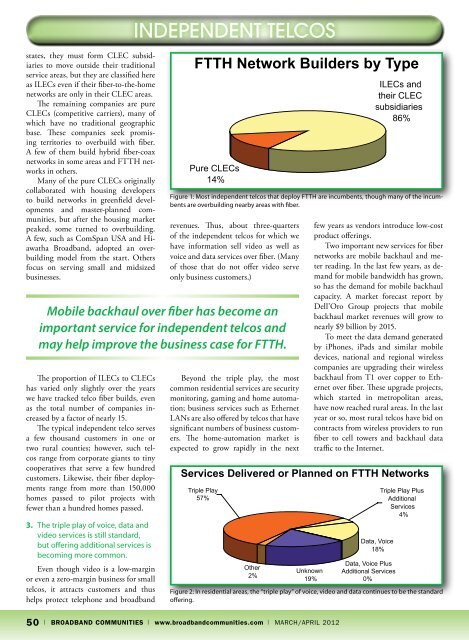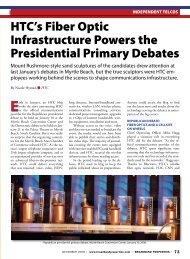March/April - Broadband Communities Magazine
March/April - Broadband Communities Magazine
March/April - Broadband Communities Magazine
Create successful ePaper yourself
Turn your PDF publications into a flip-book with our unique Google optimized e-Paper software.
states, they must form CLEC subsidiaries<br />
to move outside their traditional<br />
service areas, but they are classified here<br />
as ILECs even if their fiber-to-the-home<br />
networks are only in their CLEC areas.<br />
The remaining companies are pure<br />
CLECs (competitive carriers), many of<br />
which have no traditional geographic<br />
base. These companies seek promising<br />
territories to overbuild with fiber.<br />
A few of them build hybrid fiber-coax<br />
networks in some areas and FTTH networks<br />
in others.<br />
Many of the pure CLECs originally<br />
collaborated with housing developers<br />
to build networks in greenfield developments<br />
and master-planned communities,<br />
but after the housing market<br />
peaked, some turned to overbuilding.<br />
A few, such as ComSpan USA and Hiawatha<br />
<strong>Broadband</strong>, adopted an overbuilding<br />
model from the start. Others<br />
focus on serving small and midsized<br />
businesses.<br />
IndependenT TelCos<br />
FTTH Network Builders by Type<br />
Pure CLECs<br />
14%<br />
Mobile backhaul over fiber has become an<br />
important service for independent telcos and<br />
may help improve the business case for FTTH.<br />
The proportion of ILECs to CLECs<br />
has varied only slightly over the years<br />
we have tracked telco fiber builds, even<br />
as the total number of companies increased<br />
by a factor of nearly 15.<br />
The typical independent telco serves<br />
a few thousand customers in one or<br />
two rural counties; however, such telcos<br />
range from corporate giants to tiny<br />
cooperatives that serve a few hundred<br />
customers. Likewise, their fiber deployments<br />
range from more than 150,000<br />
homes passed to pilot projects with<br />
fewer than a hundred homes passed.<br />
3. The triple play of voice, data and<br />
video services is still standard,<br />
but offering additional services is<br />
becoming more common.<br />
Even though video is a low-margin<br />
or even a zero-margin business for small<br />
telcos, it attracts customers and thus<br />
helps protect telephone and broadband<br />
50 | BROADBAND COMMUNITIES | www.broadbandcommunities.com | <strong>March</strong>/april 2012<br />
ILECs and<br />
their CLEC<br />
subsidiaries<br />
86%<br />
Figure 1: Most independent telcos that deploy FTTH are incumbents, though many of the incumbents<br />
are overbuilding nearby areas with fiber.<br />
revenues. Thus, about three-quarters<br />
of the independent telcos for which we<br />
have information sell video as well as<br />
voice and data services over fiber. (Many<br />
of those that do not offer video serve<br />
only business customers.)<br />
Beyond the triple play, the most<br />
common residential services are security<br />
monitoring, gaming and home automation;<br />
business services such as Ethernet<br />
LANs are also offered by telcos that have<br />
significant numbers of business customers.<br />
The home-automation market is<br />
expected to grow rapidly in the next<br />
Services Delivered or Planned on FTTH Networks<br />
Triple Play<br />
57%<br />
Other<br />
2%<br />
Unknown<br />
19%<br />
few years as vendors introduce low-cost<br />
product offerings.<br />
Two important new services for fiber<br />
networks are mobile backhaul and meter<br />
reading. In the last few years, as demand<br />
for mobile bandwidth has grown,<br />
so has the demand for mobile backhaul<br />
capacity. A market forecast report by<br />
Dell’Oro Group projects that mobile<br />
backhaul market revenues will grow to<br />
nearly $9 billion by 2015.<br />
To meet the data demand generated<br />
by iPhones, iPads and similar mobile<br />
devices, national and regional wireless<br />
companies are upgrading their wireless<br />
backhaul from T1 over copper to Ethernet<br />
over fiber. These upgrade projects,<br />
which started in metropolitan areas,<br />
have now reached rural areas. In the last<br />
year or so, most rural telcos have bid on<br />
contracts from wireless providers to run<br />
fiber to cell towers and backhaul data<br />
traffic to the Internet.<br />
Data, Voice<br />
18%<br />
Data, Voice Plus<br />
Additional Services<br />
0%<br />
Triple Play Plus<br />
Additional<br />
Services<br />
4%<br />
Figure 2: In residential areas, the “triple play” of voice, video and data continues to be the standard<br />
offering.



